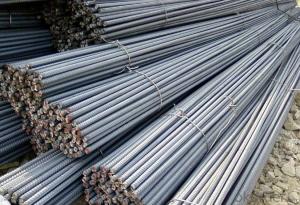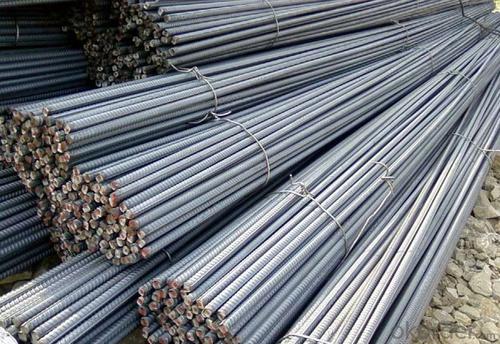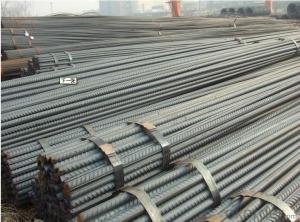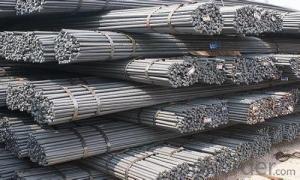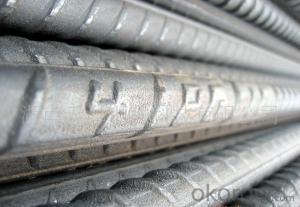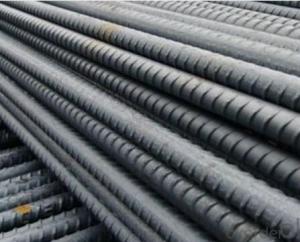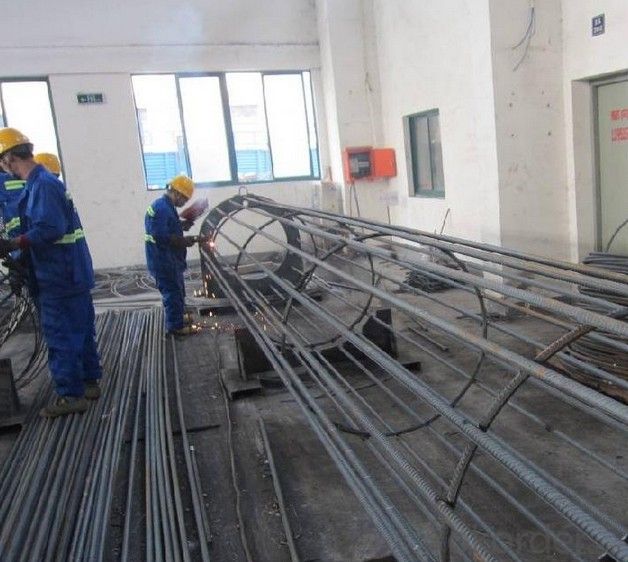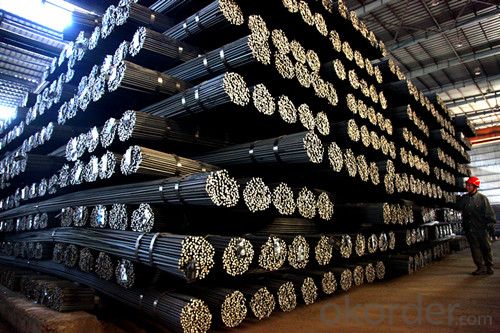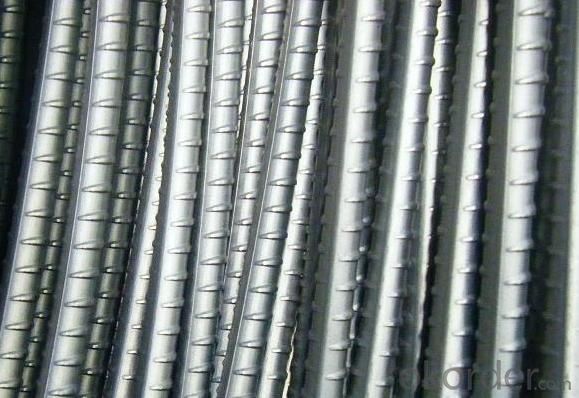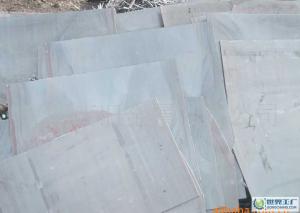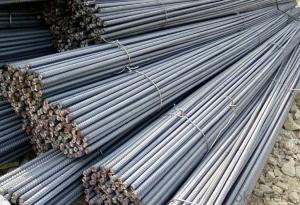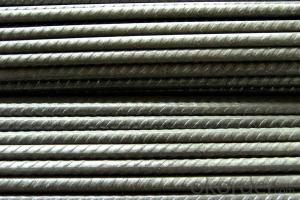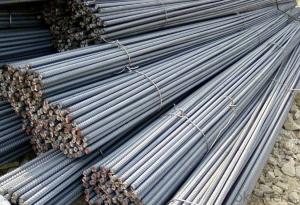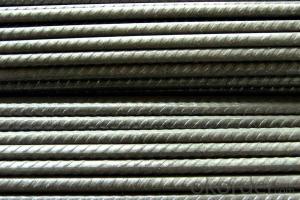High quality hot rolled deformed bar 6mm-50mm ASTM ou BS4449
- Loading Port:
- Tianjin
- Payment Terms:
- TT OR LC
- Min Order Qty:
- 25 m.t.
- Supply Capability:
- 20000000 m.t./month
OKorder Service Pledge
OKorder Financial Service
You Might Also Like
Deformed Bar Details:Product Description:Specifications of HRB400 Deformed Steel Bar:StandardGBHRB400Diameter6mm,8mm,10mm,12mm,14mm,16mm,18mm,20mm,22mm,25mm,28mm,32mm,36mm,40mm,50mmLength6M, 9M,12M or as requiredPlace of originHebei, China mainlandAdvantagesexact size, regular package, chemical and mechanical properties are stable.TypeHot rolled deformed steel barBrand nameDRAGON Chemical Composition: (Please kindly find our chemistry of our material based on HRB500 as below for your information) GradeTechnical data of the original chemical composition (%)CMnSiSPVHRB400≤0.25≤1.60≤0.80≤0.045≤0.0450.04-0.12Physical capabilityYield Strength (N/cm²)Tensile Strength (N/cm²)Elongation (%)≥400≥570≥14 Theoretical weight and section area of each diameter as below for your information: Diameter(mm)Section area (mm²)Mass(kg/m)Weight of 12m bar(kg)628.270.2222.664850.270.3954.741078.540.6177.40412113.10.88810.65614153.91.2114.5216201.11.5818.9618254.52.002420314.22.4729.6422380.12.9835.7625490.93.8546.228615.84.8357.9632804.26.3175.723610187.9998.884012579.87118.4450196415.42185.04 Usage and Applications of HRB400 Deformed Steel Bar: Deformed bar is widely used in buildings, bridges, roads and other engineering construction. Big to highways, railways, bridges, culverts, tunnels, public facilities such as flood control, dam, small to housing construction, beam, column, wall and the foundation of the plate, deformed bar is an integral structure material. With the development of world economy and the vigorous development of infrastructure construction, real estate, the demand for deformed bar will be larger and larger.. Packaging & Delivery of HRB400 Deformed Steel Bar: Packaging Detail: products are packed in bundle and then shipped by container or bulk vessel, deformed bar is usually naked strapping delivery, when storing, please pay attention to moisture proof. The performance of rust will produce adverse effect. Each bundle weight: 2-3MT, or as required Payment term: TT or L/C Delivery Detail: within 45 days after received advanced payment or LC. Label: to be specified by customer, generally, each bundle has 1-2 labels Trade terms: FOB, CFR, CIF
|
- Q: What are the common myths and misconceptions about steel rebars?
- There are several common myths and misconceptions about steel rebars. One misconception is that all rebars are the same, when in fact there are different grades and types of rebars with varying properties and strengths. Another myth is that steel rebars are prone to rusting easily, but in reality, rebars are typically coated with protective substances or used in conjunction with concrete to prevent corrosion. Additionally, some people believe that steel rebars are not environmentally friendly, but they are actually highly recyclable and can be reused in various construction projects. Overall, it's important to dispel these myths and understand the true characteristics and benefits of steel rebars in construction.
- Q: What is the minimum concrete strength required for steel rebars?
- The minimum concrete strength required for steel rebars typically depends on the specific application and design requirements. However, it is common for construction projects to require a minimum concrete strength of 3,000 pounds per square inch (psi) for standard steel rebars.
- Q: Can steel rebars be used in road construction projects?
- Yes, steel rebars can be used in road construction projects. They are commonly used as reinforcement in concrete structures, including roads and bridges, to enhance their strength and durability.
- Q: How do steel rebars affect the overall fire safety of a structure?
- Steel rebars can have both positive and negative effects on the overall fire safety of a structure. On one hand, steel rebars can contribute to the strength and stability of the structure, helping it withstand the impact of a fire and preventing structural collapse. This is especially important in high-rise buildings or structures that are vulnerable to fire hazards. Moreover, steel rebars have a high melting point, making them more resistant to heat compared to other building materials. This can help slow down the spread of fire and provide additional time for evacuation or firefighting measures. However, steel rebars can also have some negative effects on fire safety. When exposed to high temperatures, steel expands, which can lead to structural deformations and potential failure of the rebars. This can compromise the integrity of the structure and increase the risk of collapse. Additionally, steel rebars conduct heat, which means they can transfer heat from the fire to other parts of the structure. This can cause localized heating and weaken nearby materials, potentially leading to a faster spread of fire within the building. To mitigate these negative effects, fire-resistant coatings or fireproofing materials can be applied to the steel rebars. These coatings can provide insulation and protect the rebars from high temperatures, delaying their failure and reducing the risk of structural collapse. In conclusion, while steel rebars can enhance the overall fire safety of a structure by providing strength and stability, they also have some drawbacks. Proper fire protection measures, such as fire-resistant coatings, are crucial to ensure the rebars perform optimally in the event of a fire.
- Q: Can steel rebars be bent or shaped during construction?
- During construction, it is possible to bend or shape steel rebars. These rebars are commonly utilized in reinforced concrete structures to enhance their strength and stability. Although they are typically produced in straight lengths, they can be easily customized to fit the specific design requirements of the construction project. This adaptability allows contractors to reinforce different areas of the structure, including columns, beams, or slabs, by modifying the rebars. Specialized equipment, such as rebar benders or hydraulic tools, is usually employed in the process of bending or shaping the rebars. By doing so, construction professionals can guarantee that the reinforced concrete structure satisfies the necessary load-bearing and structural integrity standards.
- Q: What are the factors to consider when choosing the right steel rebar for a project?
- Several factors must be considered when choosing the appropriate steel rebar for a project. These factors encompass the project type, structural requirements, environment, and specific rebar characteristics. The project type is a key factor to consider, as each type has unique structural demands. Residential buildings, bridges, and highways, for example, require different strengths and capacities. The chosen steel rebar must be able to withstand the expected loads and stresses of the project. Additionally, its size and shape should match the project's design and specifications. Structural requirements are crucial in selecting the right steel rebar. This involves evaluating the required tensile strength, yield strength, and elongation properties. It is essential to choose a rebar that provides the necessary strength and durability to maintain the project's structural integrity. The project's environment also plays a significant role. If the project will be exposed to corrosive elements like saltwater or chemicals, corrosion-resistant rebar is necessary. This choice prevents premature deterioration and ensures the structure's longevity. Furthermore, specific rebar characteristics must be assessed. The grade of the steel, which determines its strength and ductility, is important. Different grades, such as ASTM A615 or ASTM A706, possess distinct properties suitable for various applications. The rebar's surface finish, whether plain or deformed, also affects its bonding ability with concrete. Availability and cost are additional factors to consider. It is vital to ensure that the selected rebar is readily available in the required quantities and sizes. Moreover, the rebar's cost should align with the project's budget constraints. In conclusion, choosing the appropriate steel rebar for a project entails considering the project type, structural requirements, environmental conditions, and specific rebar characteristics. By carefully evaluating these factors, one can select the most suitable steel rebar that guarantees the structure's durability and longevity.
- Q: Can steel rebars be used in structures with limited accessibility?
- Yes, steel rebars can be used in structures with limited accessibility. Due to their small size and flexibility, rebars can be easily maneuvered and installed in areas with restricted access, making them suitable for various construction projects.
- Q: What are the standard sizes of steel rebars?
- The standard sizes of steel rebars vary depending on the country and the specific construction industry standards. However, some common standard sizes for steel rebars include diameters of 6mm, 8mm, 10mm, 12mm, 16mm, 20mm, 25mm, 32mm, and 40mm. These sizes are usually used in various construction applications, including reinforcing concrete structures.
- Q: What are the safety precautions when handling steel rebars?
- When handling steel rebars, there are several safety precautions that should be followed to minimize the risk of accidents or injuries. These precautions include: 1. Personal Protective Equipment (PPE): It is essential to wear the appropriate PPE when handling steel rebars. This includes steel-toe boots, gloves, safety glasses, and a hard hat. PPE will protect against potential hazards such as falling rebars or flying debris. 2. Lifting and Carrying Techniques: Steel rebars can be heavy and difficult to handle. It is important to use proper lifting techniques to avoid strain or injury. Bend at the knees, not the waist, and use the leg muscles to lift the rebar. It is also crucial to avoid overexertion and ask for assistance when handling heavy rebars. 3. Proper Storage: Steel rebars should be stored in a secure and organized manner to prevent them from falling or rolling. Rebars should be stacked flat and not leaning against walls or other structures. Additionally, rebars should be stored away from high traffic areas to avoid accidental collisions. 4. Sharp Edges: Steel rebars have sharp edges that can cause cuts or puncture wounds. It is important to handle rebars with caution and wear gloves to protect the hands. Additionally, rebars should be stored and transported in a way that minimizes the risk of coming into contact with sharp edges. 5. Communication and Warning Signs: When working with steel rebars, it is important to communicate with coworkers and warn them of any potential hazards or activities involving rebars. Clear signage should be posted in work areas to alert others to the presence of rebars and the need for caution. 6. Training and Supervision: Workers should receive proper training on the safe handling and storage of steel rebars. Supervisors should closely monitor work areas to ensure that safety protocols are being followed and provide guidance or corrective action as needed. By following these safety precautions, the risk of accidents or injuries when handling steel rebars can be significantly reduced. It is important to prioritize safety at all times to create a secure working environment.
Send your message to us
High quality hot rolled deformed bar 6mm-50mm ASTM ou BS4449
- Loading Port:
- Tianjin
- Payment Terms:
- TT OR LC
- Min Order Qty:
- 25 m.t.
- Supply Capability:
- 20000000 m.t./month
OKorder Service Pledge
OKorder Financial Service
Similar products
Hot products
Hot Searches
Related keywords
